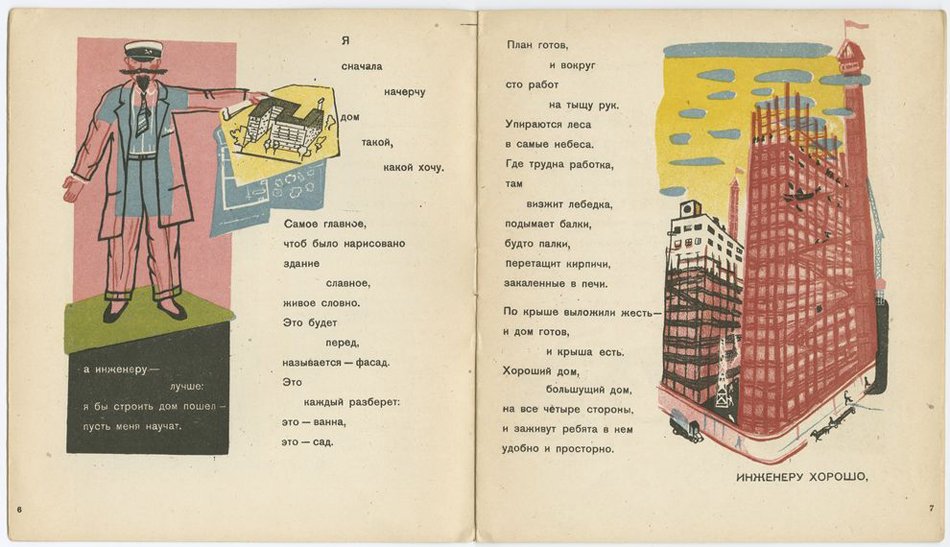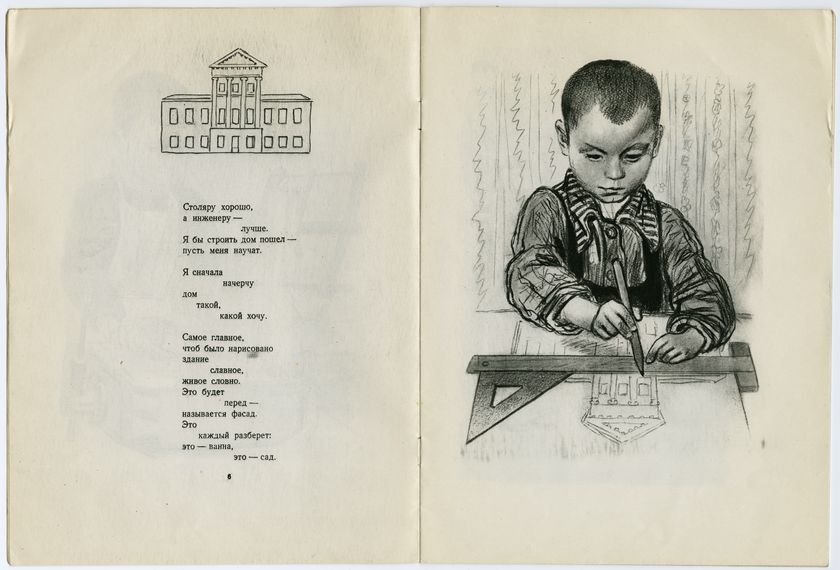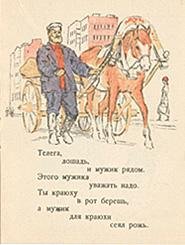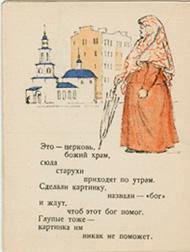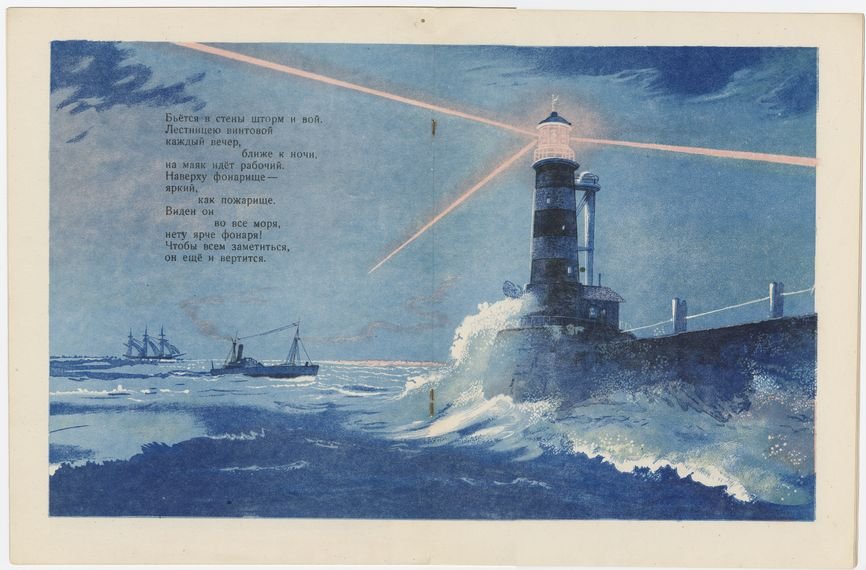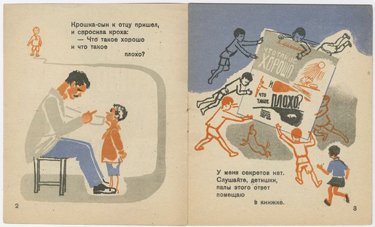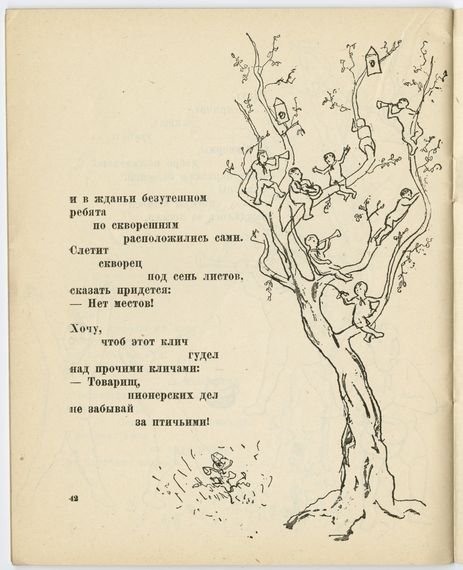Vladimir Mayakovsky
Introduction
Soviet children’s books and posters owe a great deal of their inimical look and sound to the poet Vladimir Mayakovsky (1893-1930). Mayakovsky was the most prominent of many avant-garde artists who, driven by ideological commitment and financial exigency, transformed the popular media landscape of Russia over the course of the 1920s. The goal was agitating for reform, both of social institutions and individual consciousness, and the means Mayakovsky found was a singularly brash and vivid combination of invention, abstraction, humor, and intelligence. Under his pen Russian poetry began to speak with a more flexible and expressive (even anarchic) play of sound and rhythm. The prolific Agniia Barto spoke for many when she identified her discovery of Mayakovsky’s poetry as the “pivotal moment” in her own development as a children’s writer.[1]
Mayakovsky, a trained artist, instigated the cartoon-like posters. Christened Okna Rosta (“Windows of ROSTA,” the Russian Telegraph Agency), they filled empty shop windows during the devastating Civil War. Using simple stenciled forms and sharp rhymes, a team of artists and poets attacked the enemies of the young Soviet state and extolled the virtues of peasants and workers. One of Mayakovsky’s closest collaborators for the posters was Vladimir Lebedev (1891-1967), who later became an illustrator of children’s books, including many by Samuil Marshak. In subsequent years Mayakovsky remained open to exploring new applied uses for his poetry, from advertising and sloganeering to pedagogical works for children.
Whom Shall I Be?
Mayakovsky wrote fourteen poems for children, utilizing word play and staggered, step-like verses to take language apart and allow children to put it back together in new ways. Kem byt’? (Whom Shall I Become?) encourages children to create their own identities, even as it channels their desire into specific existing roles. Mayakovsky bequeathed Soviet children’s poetry a vibrant and flexible idiom, equally well-suited for both visual presentation and being read out loud. Nisson Shifrin designed the book in such a way that the consecutive stanzas seem to interlock and overlap; the result is less a linear narrative than a kaleidoscopic fantasy of all the different professions, each one better than the last, right up to the concluding (somewhat ungrammatical) lines:
"Having turned the book inside out
Keep it well in heart:
All jobs are fine for you:
Choose
for your own taste!"
The Taming of Mayakovsky
The stylistic development of books based on Mayakovsky’s verse clearly illustrates how his rambunctious personality was tamed after his death by suicide in 1930. The difference is also clear if one compares the 1932 and 1947 editions of Whom Shall I Be?, where the abstract depictions of constructivist buildings are replaced by realistic renderings of neo-classical edifices. Andrei Brei’s figurative illustrations for Guliaem (Taking a Walk) also tame Mayakovsky’s anarchic text, which had first been published in 1926. The old woman who mistakenly believes in churches and icons looks like a paragon less of Orthodoxy than of bourgeois excess. For this edition two passages were omitted from Mayakovsky’s text, namely those which criticize the “bourgeois” with a prominent “belly” and a gossipy “lady” who spends her time powdering herself instead of working. Apparently Mayakovsky’s language and imagery in these two passages were a bit too saucy for Soviet tastes by 1938.
For the 1948 edition of Eta knizhechka moia pro moria i pro maiak Vladimir Aleksandrovich Tambi provides realistic forms in tranquil blue and green hues. It makes nonsense of the final lines (based on a pun, insofar as the poet’s name contained the word for lighthouse):
My book calls:
“Children, be like a lighthouse!
Light up the way for everyone
who cannot swim at night.”
In order to tell you this,
the words of this book
and the sketches of its pictures
were made
by uncle
Mayakovsky!
Even when pursuing clear pedagogical aims, Mayakovsky’s children’s verses retain the clear imprint of their author’s outsized personality.
by Robert Bird
[1] Agniia Barto, Zapiski detskogo poeta (Moscow: Sovetskii pisatel’, 1976) pp. 9-14.
